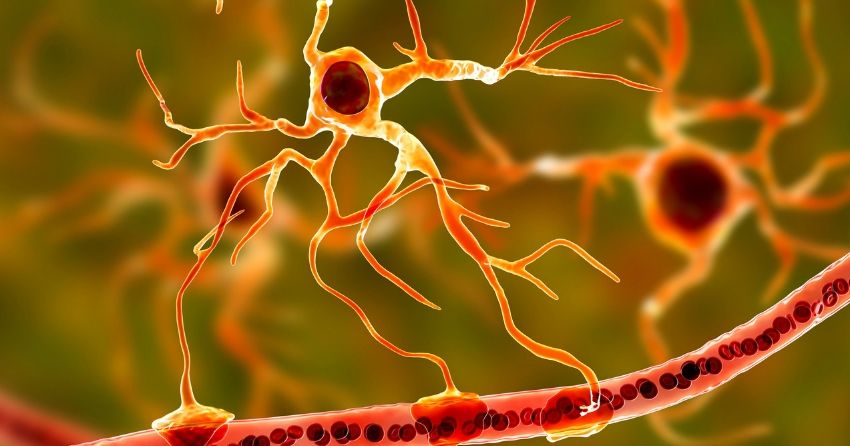Age-Related Toxicity of Star-Like Brain Cells Causes Cognitive Decline

Cognitive decline is characteristic of patients with age-related neurodegenerative disorders like Alzheimer’s disease and related dementias and cancer after chemo- or radio-therapies. Cellular senescence — a cell fate that entails a permanent cell cycle arrest — has recently emerged as a driver of these and other age-related pathologies. However, there are many open questions regarding how cellular senescence affects neurodegenerative pathologies.
The Changes That Lead to Senescence
Cellular senescence is a state in which the normal cell cycle is permanently stopped, triggering inflammation, the production of abnormal proteins, and atypical cellular metabolism. This age-related phenomenon does serve a protective purpose at a younger age, as some cells are “turned off” to prevent abnormal tissue growth that could lead to cancer.
Several different stress-related events can push cells into a senescent state. One common event is damage to cellular DNA. Genetic damage can also be a consequence of telomere shortening — when special protective structures on the tips of chromosomes are damaged and diminish in length.
In other cases, senescence may be triggered by the activation of special genes called oncogenes. Dysfunction in the mitochondria — commonly known as the power plant of the cell — may also elicit cellular arrest. External stressors may also be conducive to cellular senescence; such changes are common in the brain tissue of patients undergoing chemotherapy or radiotherapy.
This phenomenon of senescence has been widely studied in cells from different tissues in the body. And, though previous studies have demonstrated a key role for cellular senescence in aging and several age-related pathologies, including neurodegenerative diseases, it is not clear how this cellular process affects structures in the brain.
How Does Senescence Affect The Brain?
The most common cell type in the brain is a special type known as the astrocyte. These star-shaped cells play an important role in the survival of neural tissue, as they are among the few nervous cells that can proliferate.
Cell-to-cell communication is achieved through neurotransmitters, and neurotransmitter function is highly dependent on the proper functioning of astrocytes. Previous studies show that astrocyte dysfunction is associated with several different neurodegenerative diseases, such as Alzheimer’s, Huntington’s, and Parkinson’s disease (1,2).
Senescent astrocytes have been identified in the brains of Alzheimer’s disease patients, which has led researchers to study how these cells get pushed to this idle fate. The bigger question lies in understanding how senescence might alter brain function and possibly induce changes that lead to cognitive decline. Understanding the steps that lead to this dysfunctional state may provide some targets for treatment.

Astrocyte Senescence Is Linked to Neurodegenerative Diseases
For these reasons, Limbad and colleagues from the Buck Institute for Research on Aging dug into what exactly astrocytes do when they become senescent so that they can be targeted to prevent cognitive decline. They published a recent study in the journal PLOS ONE providing some insight into how senescent astrocytes might affect the brain microenvironment (3).
The authors induced senescence by exposing astrocytes to X-rays and monitoring what was occurring in these cells. Once the irradiation made the astrocytes senescent, the cells started secreting pro-inflammatory compounds. This is in line with the notion that chronic inflammation in brain tissue is an early step for neurodegenerative disease.
Also, the astrocytes that were treated with X-rays had an impaired capacity for the production of neurotransmitters — chemical substances released at the end of a nerve fiber by the arrival of a nerve impulse that cause the transfer of the impulse to another nerve fiber, a muscle fiber, or some other structure. Healthy astrocytes have neuroprotective properties, but to function, these cells need to be able to produce and process the neurotransmitter glutamate properly. But these cells had a toxic amount of glutamate, which killed neural cells by leading to a state called excitotoxicity.
In excitotoxicity, nerve cells suffer damage or death when the levels of otherwise necessary and safe neurotransmitters like glutamate, which activates neurons, excessively stimulate receptors. This can burn out the connected cells and damage the brain. Glutamate excitotoxicity is a known precursor to several neurodegenerative diseases and epilepsy (4,5). Current medications used for the treatment of Alzheimer’s diseases like Riluzole and Ceftriaxone depend on this principle.
The researchers also identified genetic changes that occur in senescent cells that lead to neurodegeneration. The genes GJA1 and APOE were upregulated in the senescent astrocytes. These two genes are involved in the abnormal protein and fat deposits that are seen in Alzheimer’s disease. The researchers speculate that the increased activation of these two genes contributes to the altered microenvironment seen in the brains of Alzheimer’s patients.
Senolytics May Be Key For Treating Neurodegeneration
The authors concluded, “Our results suggest a key role for cellular senescence, particularly in astrocytes …, which may lead to neurodegeneration including Alzheimer’s disease and related dementias.” These findings are important because scientists were aware of senescence as an age-related effect, but until now, there was no direct connection to senescence’s effect on the cognitive decline through the damage done to the brain.
Since senescent cells contribute to excitotoxicity, as seen in the origin of many neurodegenerative diseases, new pharmacological treatments could focus on the targeted removal of these cells and open the door for new strategies of treatment. Along these lines, a group of new experimental drugs aptly named senolytics has been developed exactly for this purpose. Clinical studies with senolytics are currently underway to examine their effectiveness in treating neurodegenerative diseases, such as Alzheimer’s and Parkinson’s among others.
References:
- Bitto A, Sell C, Crowe E, et al. Exp Cell Res. 2010;316(17):2961-2968.
- Maragakis NJ, Rothstein JD. Nat Clin Pract Neurol. 2006;2(12):679-689.
- Limbad C, Oron TR, Alimirah F, et al. PLoS One.2020;15(1):e0227887. Published 2020 Jan 16.
- Caudle WM, Zhang J. Exp Neurol. 2009;220(2):230-233.
- Seifert G, Schilling K, Steinhäuser C. Nat Rev Neurosci. 2006;7(3):194-206.





